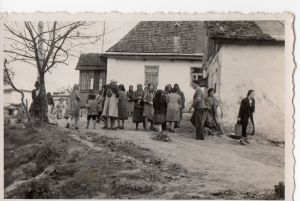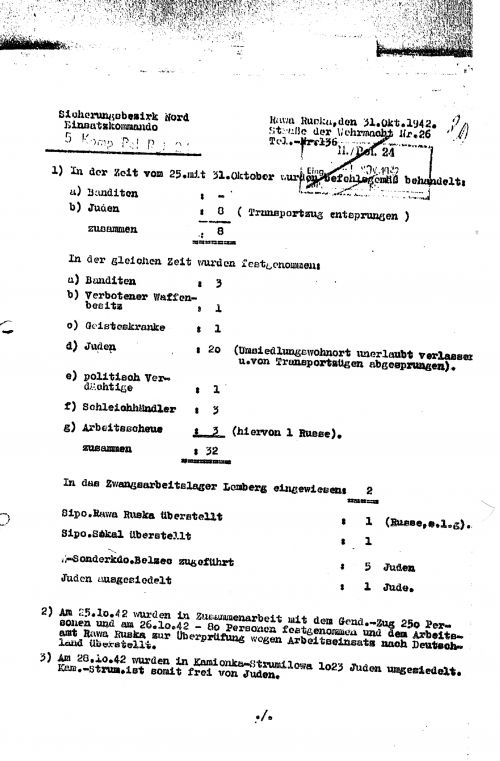Rawa Ruska

Rawa Ruska Jewish Ghetto
Rawa Ruska is located about 31 miles north-northwest of Lvov and there were 7,120 Jews in Rawa Ruska on the eve of the Second World War. After September 1939, Rawa Ruska was under Soviet occupation as part of the Molotov-Ribbentrop pact, and the Jewish population increased significantly, due to the number of refugees crossing the border between the Generalgouvernement and the Soviet occupation zone, the border was nearby at Belzec, some 12 miles away. A number of Jews were deported from Rawa Ruska to Siberia during 1940 -1941, for alleged anti-Soviet activities.
German forces bombarded Rawa Ruska, 125 houses were destroyed and others severely damaged, some 400 Jewish families were rendered homeless. The Germans occupied Rawa Ruska on 28 June 1941 and the military governed the town. On 1 August 1941, Rawa Ruska became the centre of ‘Kreis Rawa Ruska’, within the ‘Distrikt Galizien.’ The Kreishauptmann was Dr. Hans-Walter Zinser until March 1942, and then in April 1942, Gerhard Hager succeeded him.
There was a German Gendarmerie post in Rawa Ruska, a Kripo (Criminal Police) outpost, and a detachment of local Ukrainian Auxiliary Police. The Kripo outpost was subordinate to the Sicherheitspolizei – Aussendienststelle in Sokal , which was headed by SS- Obersturmführer Oswald Heyduk. Generally, the Security Police from Sokal carried out the anti-Jewish ‘Aktions’ in Rawa Ruska, assisted by the help of the local squads already mentioned. In early July 1941, more than 100 Jews were arrested and shot as alleged Communists and all through the summer and autumn of 1941, a series of anti-Jewish measures were implemented in Rawa Ruska, for example, Jews were required to wear distinctive armbands bearing the Star of David, Jews between the ages of 16 to 60 were compelled to engage in forced labour, and they were forbidden to leave the town, all against a background of beatings and robberies. As in other large towns, a Jewish Council (Judenrat) was established in Rawa Ruska almost immediately, headed initially by a German Jew named Schweitzer. In addition, the Germans ordered the creation of a Jewish Council for the Kreis (Kreisjudenrat), which could give orders to the other Jewish Councils in nearby settlements. In total, some 22,000 Jews resided in ‘Kreis Rawa Ruska,’ including the communities of Lubaczow, Niemirow, and Uhnow.
The first head of the Judenrat, Schweitzer is accused by some survivors of abusing his power, robbing people and sending them to their deaths. He was killed and replaced soon after the arrival of Kreishauptmann Hager in 1942. In November 1941, the Judenrat reported that there were 7,400 Jews residing in the town, including a number of refugees from Lvov, and other places. Some 4,500 Jews were in need of social assistance, which consisted mainly of a soup kitchen that drained most of the Jewish community’s remaining financial reserves. In addition, the Judenrat had to meet heavy contributions that the German authorities demanded and also pay the large numbers of forced labourers. In the winter of 1941-42, the Jews had to surrender their fur clothing to the Germans, and several hundred able-bodied Jews were deported to forced labour camps. The systematic destruction of the Jews of Rawa Ruska began in the spring of 1942. The first ‘Aktion’ took place on 19 March 1942, when approximately 1,000 Jews were arrested on the streets and from their homes and places of work and were deported to the newly opened Belzec extermination camp, which was located some 12 miles northwest of Rawa Ruska. In late July 1942, a second anti-Jewish ‘Aktion’ took place in Rawa Ruska. The first company of German Police Battalion 133 and 60 Ukrainian Auxiliary Police from Lvov, as well as the Judenrat and the Jewish Police took an active part in the ‘Aktion,’ along with the local Gendarmerie and Ukrainian policemen. During the ‘Aktion’ another 2,000 Jews were deported to Belzec. Along with them were deported hundreds of Jews from Niemirow and Uhnow. The considerable number of trains containing Jews passing through Rawa Ruska in the summer of 1942, and the proximity to Belzec itself, meant that the local community soon received a clear impression of the fate of the Jews throughout the ‘Distrikt Galizien.’
A few weeks after the second ‘Aktion,’ in August 1942, the Germans began to concentrate the Jewish population in Rawa Ruska, designating three streets in the poorest section of the town as an open ghetto. In this area there was no electricity and only two wells. Then in late September and early October 1942, Jews from Magierow, Niemirow, Uhnow, Potylicz, Lubycza, Krolewska and other nearby places were transferred into the Rawa Ruska ghetto. In addition, a number of Jews who had escaped from the trains heading to Belzec, also sought refuge there. As a result, the number of Jews in the ghetto rose to around 10,000 or more. Despite the new influx, the area of the ghetto was not increased at all. This led to tremendous overcrowding, with two or three families, between twenty and thirty people, living in each room. Together with the severe lack of food, water, warm clothing, and medicine, the appalling living conditions soon led to a large-scale outbreak of typhus in the ghetto. About ten to twenty people died daily from the disease. At the start of December 1942, the ghetto was declared closed. Jews were no longer permitted to leave the ghetto to go to their places of work. Fearing a further ‘Aktion,’ many Jews prepared bunkers and other places. In December 1942, the SS-und Polizeiführer Distrikt Galizien Friedrich Katzmann, used the severe typhus epidemic as a pretext for liquidating the Rawa Ruska ghetto. The liquidation ‘Aktion’ took place during 7 -11 December 1942, with the assistance of a squad of Security Police from Sokal, the Gendarmerie the Ukrainian Auxiliary Police, and the operational squad of the 5th Company of Police Regiment 24. In the report of 30 June 1943, prepared by Friedrich Katzmann, the circumstances of the ghetto’s liquidation are described as follows: The Rawa Ruska Jews, fearing an evacuation, hid those who were ill with typhus in holes in the ground. When the evacuation was set to begin, it was discovered that 3,000 Jews, sick with typhus, were lying around in the ghetto. All police officials, who had been vaccinated for typhus, had to be called upon immediately to destroy the source of the infection. Thus we were able to destroy this source of the plague, losing only one person in the process. During the liquidation ‘Aktion,’ at least 5,000 Jews were shot on the spot, 2,500 were deported to Belzec in four trains, and several hundred young Jews were deported to various labour camps. The operational squad of the 5th Company of Police Regiment 24 alone shot 750 Jews during the ‘cleansing’ of the ghetto territory, according to the report dated 12 December 1942.

Einsatzkommando Report from Rawa Ruska (USHMM Washington DC
After the liquidation of the ghetto, approximately 60 Jews were left alive in the town, housed in a separate barracks outside the ghetto, to bury those killed. Some of the young workers returned from the labour camps, three weeks later and they were employed in collecting, organising and sorting property from the Jewish homes and cleaning the territory of the former ghetto. Aside from these ‘legal Jews,’ about 250 to 300 illegal Jews were hiding in the ghetto, the ‘legal Jews’ provided them with food. The Germans shot many of the ‘illegal Jews ’ on sight. In March 1943, they shot the burial team, and the remaining 100 or so ‘legal Jews’ stayed in the ghetto until June 1943. The first head of this remnant ghetto from mid-December 1942 until mid-February 1943 was SS-Hauptscharführer Josef Grzimek, who from 19 February 1943, was the head of the ‘Judenlager’ in Lvov. On 1 May 1943, the remaining 300 to 400 Jewish inmates from the liquidated labour camp in Mosty Wielkie, which was located 23 miles east of Rawa Ruska, was transferred to Rawa Ruska. Here they were accommodated in 10 barracks and were employed in repairing and building roads. In June 1943, the Germans shot all these Jews, together with the others remaining in Rawa Ruska, as Kreishauptmann Hager, refused to provide them with food. The Germans even lured the remaining illegal Jews out of hiding with a false promise to send them to the labour camp at Porylicz if a specific sum of money was collected. The final massacre of the remaining Jews took place during 8-10 June 1943, in a mass grave in the forest near the village of Borowe, just to the west of Rawa Ruska. Local inhabitants were required to fill in the mass grave, blood streamed out and the ground continued to heave for some time after the shooting. Some witnesses recall that one group of victims was blown up with dynamite, scattering body parts around the vicinity.
On 29 January 1949, former SS-Hauptscharführer Josef Grzimek, head of the Jewish labour camp in Rawa Ruska, was sentenced to death in Poland, he died in prison during 1950. On 13 July 1949, former SS-Obersturmführer Oswald Heyduk was sentenced to life imprisonment in Munich, then West Germany.
Sources:
Encyclopedia of Camps and Ghettos 1933-1945 -Volume II , Indianna University Press, Bloomington 2012
Y. Arad, Belzec, Sobibor Treblinka, Indiana University Press, Bloomington and Indianapolis 1987
Photograph - Chris Webb Private Archive
Document - USHMM -Washington DC
© Holocaust Historical Society September 2, 2021

